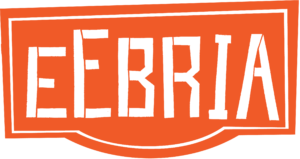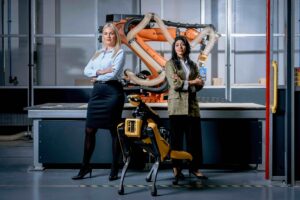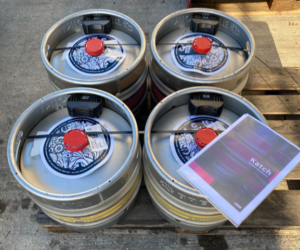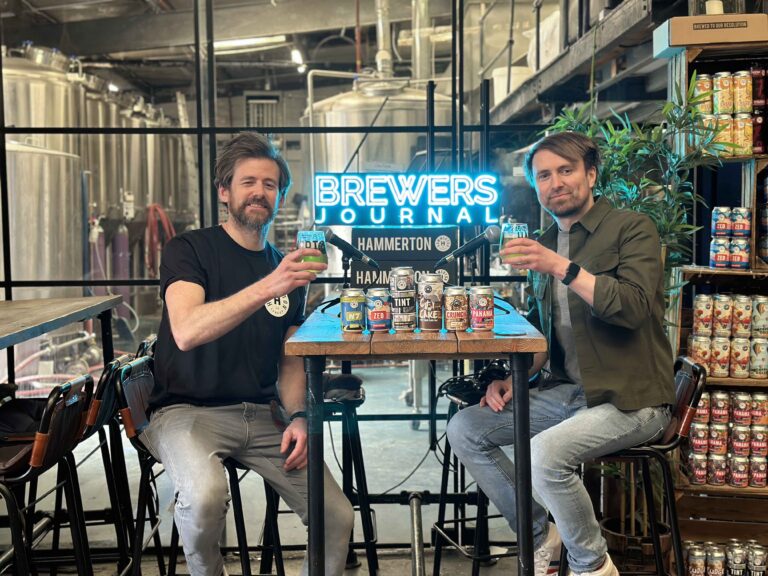Life has a funny way of working out, even if you weren’t sure what you were looking for in the first place. For Miranda Hudson and her co-founder and husband Bates, a chance encounter at a wedding a decade ago would eventually lead them to up sticks, start a new life in the country and open Duration Brewing – a farmhouse brewery making beers that belong. Photo credits: Chris Coulson, Henry Muller, Mark Newton, Steve Rimington, Theresa Undine.
When you know what you don’t want to be, that really helps you find who you do want to be.”
Miranda Hudson knows both side of this coin. And as co-founder of Norfolk’s Duration Brewing, she’s found her calling.
This doesn’t mean she values her previous careers any less, however. Whether that was running a charity, a costume department or working in the field of interior design, they have helped form who she is today.

Along with co-founder, and husband, Bates, these previous life experiences both professional and personal have helped inform the collective ethos they adopt to the brewery they call Duration to make beers that belong.
And for an outfit that only sent out the first beers from its West Acre brewery in Norfolk last December, they’ve certainly needed that sense of focus as the industry headed into the limbo year they call 2020.
“Putting those beers out was a real moment; it felt like we finally landed,” Hudson recalls. “We certainly had a long gestation period. But it’s important to remember that companies don’t simply exist. This brewery has been bubbling away in Bates’ mind since his early 20s, and there is still plenty of time to mature into things. This is just day one.”
She adds: “It’s been an epic journey just to get operations underway and open for business. I’ve had to just stay focused on our end goals and work bloody hard. This is our vision and we want to own it completely”.
Duration Brewing secured planning consent to put their brewery on a scheduled monument site in a grade II* building back in September 2017. Since then they’ve worked with partners Manchester’s Cloudwater and Oslo’s Amundsen to produce beers nomadically. That’s in addition to an array of collaborations with UK breweries including Deya, Verdant and Burning Sky.

It’s been a few years coming leading up to that first brew in their own home, and Hudson knows that hard work doesn’t stop there.
“We are now in another period of thinking, of contemplation. The focus is different now, and the tempo has changed a bit that’s all,” she says.
According to Hudson, the last few years have been full of self doubt and it’s something she’s reassuringly confident with.
“Doubt is helpful, it lets us consider all outcomes. I believe if channeled well then a bit of fear along with a lot of desire can be a huge driver,” she explains. “Of course at times it’s seemed impossibily difficult and I have often question my ability to pull everything together. Bates has a ridiculously ambitious vision and it has been my job to implement it. I had to get this right.”

Some 10 years earlier, and 4000 miles across the Atlantic, Hudson was at the tail-end of world trip. After visiting 10 countries with only her backpack for company, she stopped in to visit an old friend in Charleston, South Carolina.
“My friend Alex was heading out to a wedding when I got there. That’s ok, I thought. I can entertain myself but instead she suggested I gatecrash,” Hudson recollects.
The venue would be the antebellum era Boone Hall Plantation & Gardens in Mount Pleasant. Bourbon was pouring, food was plentiful and there was dancing to be had by all. Ms Hudson included.
“I remember being on the deck shucking oysters and thinking what a blast I was having, eating low country boil and thinking how it was more a shindig than a wedding, when I saw Bates,” she recalls.
“He looked like a complete rebel rouser with a towering mowkhawk and nails in his ears but was the perfect gent who asked ‘Do you care to dance?’ then proceeded to kick it kid’n’play style with me on the dance floor!”
“Despite being a quiet and introverted individual, he certainly wasn’t afraid of standing out that night,” Hudson says.

Her trip would soon come to an end and Bates, as he is known, would drive Hudson to the airport for her flight home.
As they parted ways, he left the Londoner with a four-page letter and the parting words:
‘There are no four corners of the earth I won’t travel to see you.’
“It knocked me sideways. He’s a hard nut to crack but he left me intrigued,” Hudson muses.
The wedding they both attended was on the 20th March and Hudson returned to the UK later that month. By early May, Bates had joined Hudson in the UK.
“This huckleberry fin that had never left the US nor had a passport until then, rocked up in Brixton convinced we were going to have this whole new life together. And here we are!”
Putting those beers out was a real moment; it felt like we finally landed,” Miranda Hudson, Duration Brewing.
Arriving on 6th May, Bates would then stay for six months. He absorbed and consumed the wealth of culinary experiences Europe had to offer, and how these dovetailed with his own growing up in South Carolina. It would also prove to be far from his latest visit to these isles, either.
The proceeding year would see the duo travel back and forth from the US to the UK. Bates would tragically lose his brother due to a car accident in this time but there was clearly a strong union between Hudson and Bates.
Our life experiences, as we all know, can have a strong impact on focusing the mind.
“I went to my mum’s for a ring. If I was going to be the one proposing, and I was getting this ring back, then I should be the one choosing it!” she laughs.
It was the 24th July 2011, the day after musician Amy Winehouse died. Bates was cooking at an event hosted by Secret Garden Party founder Freddie Fellows.
“I thought life’s too short, heroes die, just let him know you are in it for the long haul with him. So I turned up, and Bates was basting a whole pig in a pit in an apple orchard. I took him to one side and asked the all-important question. ‘Sure!’ was his response and that was that,” Hudson explains. The couple would wed at Brixton Town Hall and by 2012 their daughter Mila was born.

In the years that would follow, Bates would take on a variety of roles in the world of food and drink. A creative behind the formation of US-themed street food outfit MeatLiquor he’d help shape the menu and the business as it made its foray into bricks-and-mortar restaurants.
Come 2013, he would move to BrewDog as Head of Food to head up the fit-out, menus and kitchen training of the brewery’s bars as it ramped up its cuisine offering across the UK.
This role called on his experiences working at several breweries and restaurants in Charleston such as slow food locally focused Stella’s Bistro in Greenville and Thomas Creek in South Carolina. Skills he’d also put to good use upon joining Bermondsey’s Brew By Numbers where he became head brewer.
Working across these businesses as they grew would inform Bates’ vision of what a brewery of his own could look like, and the approach he would take were he at the helm. Before Duration came into being, initial conversations with other parties floated the idea of a London based brewpub offering. But, for someone that had grown up surrounded by mother nature, the hustle and bustle of city life was never going to sit well when it came to settling on a brewery forever home.
That’s where Norfolk, the River Nar and a beautiful centuries-old priory site would enter the conversation.
“At beer events we’d go to together, I would always focus on the interactions. Beer was the access point – people get really involved about it” says Hudson. “Every time the idea came up, of us doing something ourselves, I found myself overwhelmed with the gravity of everything and what I’d need to learn. Until I step back and think I just need to allow for those interaction to happen and create an audience for the beer Bates wants to present – that’s all I need to get right.”
But there was little need for worry on the technicalities. The formation of Duration Brewing would be “long and slow”. Amidst fundraising, planning and design meetings Hudson continued to grow the brand while learning more about the brewing process and all that surrounds it.

“I’m a project manager, and while this project was bigger than any renovation project I’d undertaken but I’m ambitious. I had to take care of the big picture – timelines, budgets, stakeholders and put Bates on the detailing” she says. “The biggest challenge in all this was lifting the lid on Bates’ brain to ensure I delivered his pretty complex mind map. It’s pretty weird having your husband as your client.”
By 2018, it was make or break for what would be Duration Brewing. And as Hudson, says, it was a year involving a lot of sums.
“A lot needed to happen in the right sequence or we’d have a domino effect. If the sale of our house went through successfully and if grant money came through and If the build ran to time and budget we could get opened. We had the builder, we had the quotes, but literally nothing could fall down at any point or the whole thing would break,” she explains.
After meticulous planning the project broke ground in October 2018 following 18 months in the planning. The 44 week build followed by the seven week brewhouse installation over ran by just four days and Duration’s first brew took place on 23rd October 2019.
“It was like the longest episode of Grand Designs ever!” Hudson laughs. “Things can still fall down, and if the COVID-19 pandemic had hit just a couple months earlier than we wouldn’t have got to finish brewery we have today. We’re very fortunate.”
Hudson also feels very grateful for the industry support given to the duo in the months and years leading up to the brewery’s opening.
She says: “The help we’ve been given melts my heart. We’ve swapped knowledge and learned from our peers. And all the events and passionate people we meet out and about has kept me sane. If I was only number crunching when looking up at this mountain, I think it would have killed me. I feel like we’ve been willed into being because others in our industry genuinely want us to fill a niche and grow the scene”

In this time, Hudson says the increased visibility of the would-be brewery, thanks to the collaboration beers and those brewed on their behalf by the aforementioned Cloudwater, kept them in the public eye.
“It took on a life on its own. Momentum was building and there was no backing out!” she recalls.
Duration Brewing would go on to open its doors in October 2019. The duo invested heavily in the brewery’s location, and the same applies to the equipment housed within.
The thought behind the brewhouse and packaging procurement, as Bates says, was to find the best affordable equipment for their beer styles and taking as few concessions as possible.
“Considering why and how the brewhouse should perform, we spoke at length with manufactures on their equipment advances and process flows. As an inquisitive experienced brewer building a start-up business, we found BrauKon went the extra mile to find very specific solutions to our demanding parameters.”
Bates opted for a 20hl brewhouse with three fermentation vessels and a single 40hl bright beer tank to start. A brew day starts with a two-roller malt mill to auger crushed malt in on a chain conveyance system. Milling the malt to each brew is a small step that helps ensure malt quality.

They allowed the footprint space for a fourth vessel to add process efficiencies when production increases. They have an 80 hectolitre hot water tank and a 40 hectolitre cold water tank. Again an increase to allow a double brew day.
“The main three brewing vessels are a dual-purpose mash/boil vessel, a lauter vessel, and a whirlpool. A big factor in choosing BrauKon was the flexibility enabling a wide variety of beer style and techniques,” he says.
Bates adds: “The most four most basic steps in brewing: Mashing, lautering, boiling and whirlpooling. After these four steps on the ‘hot side’, the liquid is cooled and transferred to the ‘cold side’ or cellaring in a fermentation vessel where yeast can be pitched to start the fermentation process.”
The mash/boil vessel is jacketed and therefore temperature controlled. This allows the brewery to first heat the mash to stop and enzymatic action before sending to the lauter.
In addition, the kit has the ability to decoct mash. For malt-forward beers like lagers, decoction mashing takes a portion of the grist in isolation from the main mash and brings it to a boil to enhance ‘malt’ flavour.
The outfit also have the ability for turbid mashing, popular with lambic brewing techniques and also ideal for their spontaneous, mixed culture and slower beers.
Elsewhere, a whirlpool and hop cannon are other strings to the brewery’s bow.
“The more we dig into hop research the more we feel these hops if added at a slightly lower temperature than boiling (ie 80-85C rather than 100C) can contribute much more oil – the aroma and mouth feel contributors, and much less bitterness or astringent qualities,” says Bates.
He adds: “Normally this is pretty tough to do without rigging up the whirlpool or by adding cold water at the end of the boil (liquor backing). We opted to add an oversized Kelvion heat exchanger between our boil kettle and whirlpool. Chilling the wort to a precise overall wort temp before releasing it back to the whirlpool and adding hops. Thereby turning the humble whirlpool into a more precise instrument for hop extraction.”
On the packaging front, the ability the can its beers has helped ensure Duration can sell and distribute its beers during the challenging conditions brought on by the global pandemic. The company became the first UK business to invest in a canning line from Colorado’s Codi, supplied by UK-based Core Equipment.
A CODI CCL 45 counter pressure canning system is a three-head counter pressure canning line that can fill 25-30 cans per minute in an enclosed environment purging with CO2. Each can gets a twist rinse using air and gravity when coming off the depalletizer.
The thought behind the brewhouse and packaging procurement, was to find the best affordable equipment for our beer styles and taking as few concessions as possible,” Bates, Duration Brewing.
A de-ionized air tunnel blows out dust and debris from the can on the twist. An in-house manufactured precise mechanical driven can seamer along with the depalletizer manufactured by Codi integrates perfectly with the canning line.
The beers brewed and packaged on these systems have garnered a high mount of praise. Demonstrating subtlety and nuance, they invite the opportunity for closer inspection and appreciation, as much as they welcome the consumption of one after another over casual conversation.
Turtles All The Way Down is an American Pale showcasing Hallertau Blanc / Mosaic hops while Doses and Small Doses are 5.1% and 3.7% Pilsners. Excellent 3.0% Table Beer, You End Up Where You Where, complements the 6.2% IPA Strong Opinions, Held Lightly.
These clean, fresh beers are the yin to the yang of the beers that will emerge from Duration’s wood division, which is home to three 17HL vessels custom made by Foeder Crafters of America and a 44hl coolship designed and made by 6ix Fab Dec in the UK.
Bates explains: “Our horizontal American white oak foeders can be utilised a myriad of ways. Sized for smaller batches of the most experimental styles in our offering and seasoned each for specific use. I added customised top ports and internal plate chillers too.
“Why let a barrel go in and out with the seasons if you know where the beer will be happiest? Why wouldn’t you want put it there and help it out, less vessel time = less rent to pay too right? Perhaps the most fascinating thing I admire about Foeder Crafters is the machine engineered dual-locking grooved staves. These precision cut staves interlink in a way that allow the vessels to ‘breath’ without ever leaking, or allowing additional Co2 ingress.”
Each foeder has been seasoned with steam or by being toasted on the inside to enhance flavour profiles. The first of this foeders features no toast, heavy steam, which promote nuanced and low oak tannin/characteristics.

The second, light toast, heavy steam, offers the same but the “added bass note” of light toast. The final foeder is specified as heavy toast, light steam, which “is essentially a big old bourbon barrel at this point”.
“All the oak is still there, no steam bleaching, loads of char and roastiness, vanilla, honey and chewiness. This one is made for the stouts, the Dunkel’s, hell maybe even at some point a red grape/roast beer hybrid,” he says.”
Each vessel features the addition of a top port, which makes it easy to allow additions without a large manway opening with an unhealthy ingress of oxygen.
“Even though some of the beers coming out of the foeders may be mixed fermentation I’ve never been able to understand why some folks think these styles of beer are deemed “bullet-proof” to oxygen pickup,” says Bates. “Why would you have any lower standards to than with “fresh beer” production?”
The water used to brew Duration’s beers, regardless of their maturation home, has been a major aspect of the brewery’s build.
Inbound, the goal was to remove the carbonates undesirable to making great beer and to preserve their brewing equipment from clogging thick with calcium.
Outbound the challenge was far more complex. With no mains drainage infrastructure to connect to at their remote location, the duo needed only clean water to flow back to their watercourse.
They turned to Voltea and Enereau, which both treat water supplies for clients in the USA and Europe. Voltea’s capacitive di-ioniser cleans inbound water using direct electrical current instead of RO and Enereau uses an aerobic ‘living gill’ in a membrane bioreactor to clean and collect outbound water for reuse. Duration is the first UK brewery to adopt both of these company’s technologies.

Through the use of direct electrical current Voltea’s patented CapDI technology purifies water without the need to add back minerals as after a typical reverse osmosis (RO) process that entirely strips the water. Voltage can be tuned to effectively meet any water recipe.
Duration settled on the Enereau Membrane BioReactor (MBR) to be the best available technology for the application.
Running at much higher mixed liquor concentrations than conventional solutions, the footprint of the Enereau MBR is less than 1/3 of the space required for alternative technologies. Additionally, the combination of aerobic biology with advanced membrane filtration creates an almost absolute barrier to contaminants entering the environment from the brewery.
The resulting effluent from the wastewater plant will be to a quality standard that is high enough for reuse within the brewery, providing it with a sustainable and renewable source of reuse water for its process water requirements.
As a literal connection to the land and water that surrounds Duration, the consideration taken with this element of the business, as with all others, is indicative of the duo’s approach from day one. That’s to do it well, to do it slowly and to do it right.
“Bates and I have been in a union for 10 years. We have similar views on a lot of things but operate in different ways,” explains Hudson. “I speak on the outside and he looks within, finding his answers slowly. It creates a push and pull. It promotes momentum, in our personal lives and how we approach Duration, too.”
She adds: “We’re only a few years into our story though it feels much longer. We’ve learned a lot and will continue to do so. But what I do know is this; staying at a certain size allows you to be at your most creative and really that’s why we are in this, to create in beer. And I can’t wait to discover and share that creativity with everyone.”
Photo credits: Chris Coulson, Henry Muller, Mark Newton, Steve Rimington, Theresa Undine.









